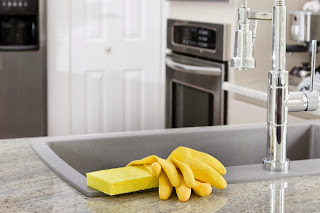Five Suggestions for Maintaining a Clean Kitchen
By Clifford WoodsBacteria can live just about anywhere, however the kitchen appears to attract germs a lot more than any other room in the house. This is mainly due to the daily food preparation and the level of moisture. Along with more stories than ever of food poisoning, people who cook at home have become more conscious of the dangers of bacteria and germs in the kitchen.
Consider each of the possible areas in the kitchen that can hold viruses such as the sink, counter tops, stoves, microwaves, table tops, floors, and chairs as well as dozens of small kitchen products that make food preparation so hassle-free. With the amount of possible ways germs can infest the kitchen; it is great to know how you can stop them dead in their tracks. Let's take a look at five simple ways for keeping your kitchen free of germs.
Stay organized: Disorder makes it very hard to wash the counter tops, cupboards, and so on. When a counter top has a great deal of products kept on it, you may have been enticed to only wipe down and clean the obvious areas. Also, organize and clean your cabinets from time to time and wipe them down with an organic solution.
Replace your dishcloths and sponges frequently. Dish cloths must be cleaned in hot water to eliminate germs. Hand towels should just be used to dry your hands and never to clean up splatters on the counter tops. Once used to dry hands you should hang them up to dry and for others to use. Make use of paper towels for leaks and spills.
Handling raw food: Cleaning raw ingredients can help get rid of a number of germs. Additionally, keep raw foods far from other ingredients. Eggs really should be stored in their carton and meats need to be placed in their proper product packaging in order to avoid contact with other products.
Keep Hands Clean: One of the most typical ways viruses spread is by means of our hands. We touch raw ingredients, after which we forget and grab something from the cupboard, or touch the fridge door. We might grab a utensil from the cabinet after coming in contact with raw foods. Just make sure you remember to wash your hands after working with any sort of raw product, especially meats.
Wash Electrical Devices: Electrical devices often end up being the most ignored things in a kitchen, however these can easily hold germs the same as every other item. The can opener, as an example, has food particles from the can that get onto the blade as it is opening the lid. The coffee machine may become a mating ground for bacteria and mold, especially if you leave water in the reservoir over night.
Microwaves usually have food stuck to the walls or platter when cooking, so be sure to cover all food items when heating them up to prevent this. And do make sure all electrical devices and things mentioned above are thoroughly cleaned regularly.
Maintain Clean Counter tops: Use an organic cleaner to wash your counter tops after every meal. Even though you might not have placed food right onto the counter, there will probably be bacteria from the utensils, product packaging, and even your own hands. Counter tops must also be cleaned after snacking and right after bringing in food from the store in grocery bags because the bags have made contact with many dirty surfaces.
For example, the clean bags used for transporting your food products first make contact with the baggers hands, then the cart, after which it is placed in your trunk; lots of places to pick up germs, so clean your counter tops!
Furthermore, if your own hands are not clean then you are putting even more germs onto the bags. It is advisable that you throw out these bags when flu season is around, just to be on the safe side.
* * *
Clifford Woods is the CEO of Effective Environmental Services and Organic Environmental Technology
We brew Beneficial Microorganisms that eat toxins and offer Natural Organic Solutions.















